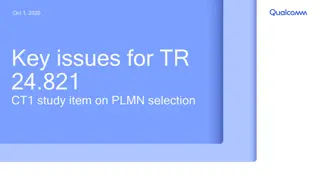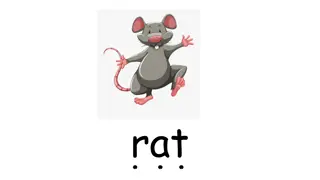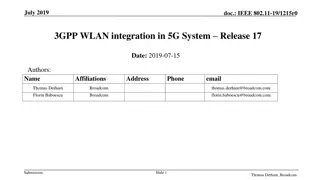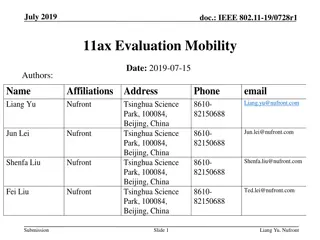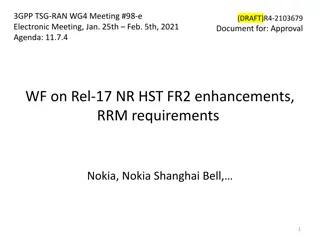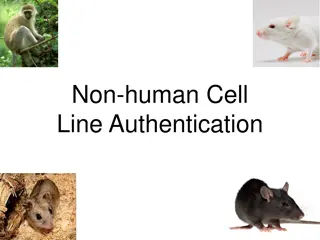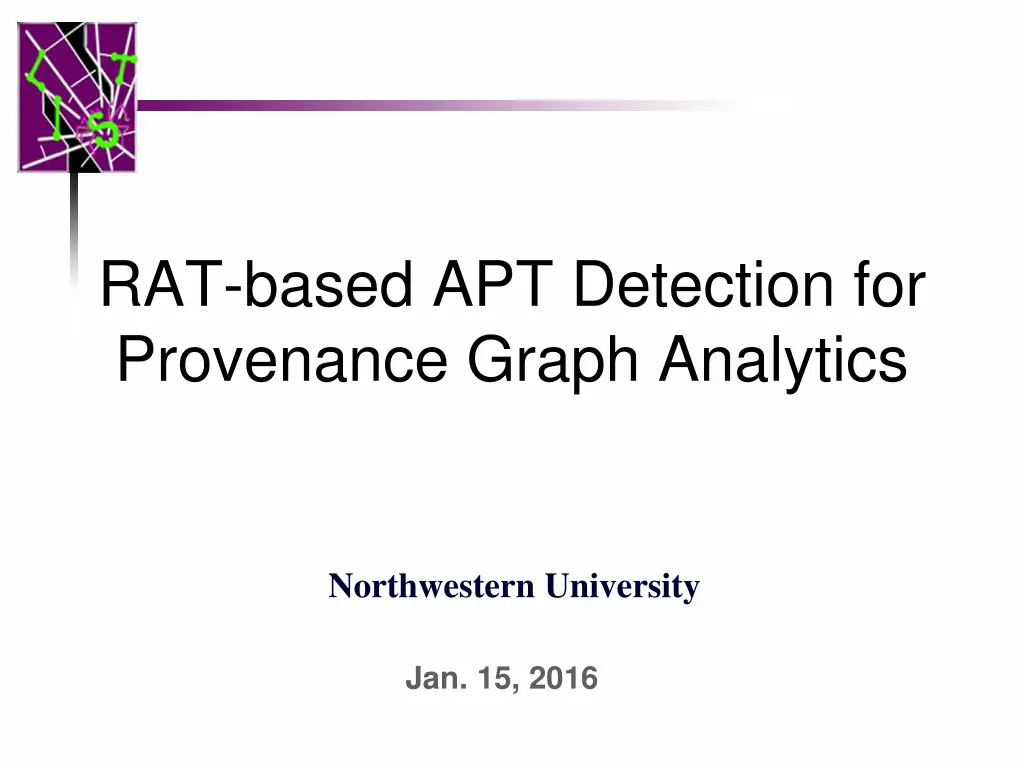
Understanding Malicious RATs: Threats and Detection Techniques
Explore the world of Remote Administration Tools (RATs), their evolution from the first malicious RAT to modern variants, architecture, typical features, and the difference between RATs and bots. Learn about detecting and combating malicious RATs to enhance cybersecurity posture.
Download Presentation

Please find below an Image/Link to download the presentation.
The content on the website is provided AS IS for your information and personal use only. It may not be sold, licensed, or shared on other websites without obtaining consent from the author. If you encounter any issues during the download, it is possible that the publisher has removed the file from their server.
You are allowed to download the files provided on this website for personal or commercial use, subject to the condition that they are used lawfully. All files are the property of their respective owners.
The content on the website is provided AS IS for your information and personal use only. It may not be sold, licensed, or shared on other websites without obtaining consent from the author.
E N D
Presentation Transcript
RAT-based APT Detection for Provenance Graph Analytics Northwestern University Jan. 15, 2016
Motivation ~300 APT White Papers [1] Most APTs are on Windows and involves malicious RATs Malicious RAT APT lifecycle [2] Establish foothold Escalate privileges Internal reconnaissance Move laterally Maintain presence Complete mission Initial compromise [1] https://github.com/kbandla/APTnotes. [2] APT1: Exposing One of China s Cyber Espionage Units, Mandiant, 2013. 2
What is a RAT? RAT stands for Remote Administration Tool, a piece of software that allows a remote "operator" to control a system. Interpreted as remote administration Trojan in some white papers. A malicious RAT is a backdoored spying horse zombie, in essence. Trojan - Disguises its identity as legitimate program. Backdoor Enables remote control and receives commands. Spyware Gathers information stealthily and sends back to master. Zombie Behaves like a zombie (allows its master to perform operation through it). 3
First malicious RAT and Today 1stmalicious RAT o Back Orifice is one of the first RATs, released in 1998. o It includes a GUI control panel. o Spawn/kill processes, play audio files and capture videos. Malicious RAT Today o An abundance of different RATs: NetBus, iControl, Sub Seven, Beast Trojan, Bifrost, Blackshades, DarkComet, LANfiltrator, Win32.HsIdir, Optix Pro, o RAT has become a service available to people without much computer knowledge. 4
Architecture of a malicious RAT Client/Server architecture o Server program installed on victim s machine o Client program with GUI installed on C&C server o Server program is remotely controlled by Client program RAT Server (unobtrusive) RAT Client (GUI) Control Response C&C Server Victim s Machine 5
Typical Features of a malicious RAT VM detection Antivirus tool detection/disabling File/registry/process manipulating Shell control Credential stealing Webcam/microphone access Keystroke logging Screen capture Network monitoring ... Features of DarkComet www.darkcomet-rat.com 6
Malicious RAT vs Bot Targeted attack vs. random attack o APT are targeted attacks with reconnaissance while most botnets are kind of random attacks, relying on port scan for victim discovery. Human manual operation (w/ vs w/o) o RAT is much more complex and powerful, and must require human operation, while bots are usually automatic programs without requiring human-driven activities. Attack Intention o RATs are mainly used for spying on victims while bots are typically harvested for orchestrated attacks. 7
Malicious RAT vs. Legitimate Program Malicious RAT vs Enterprise/Commercial RAT o They resemble each other, except a few features such as VM detection and antivirus tool detection/disabling. Malicious RAT vs other Legitimate Program o Malicious RATs have many distinct features that legitimate programs do not have: Keystroke logging Network connection monitoring File/registry/process manipulating Etc. o RATs always stay hidden while legitimate programs typically interact with users and show itself by displaying windows, buttons, dialog boxes and so on. 8
Related Work Very few academic works related to RAT detection o Z. Chen, P. Wei, and A. Delis. Catching Remote Administration Trojans (RATs). In Software Practice and Experience, 2008. o K. T. Gard sen. Detecting Remote Administration Trojans through Dynamic Analysis using Finite-State Machines. Master thesis, 2014. Industrial efforts on APT detection o Redline [1], a memory forensics tool designed by FireEye, provides host investigative capabilities to identify malicious activities through memory and file analysis. Volatility [2] - an open source memory forensics framework for incident response and malware analysis [1] Redline: https://www.fireeye.com/services/freeware/redline.html [2] Volatility: https://github.com/volatilityfoundation/volatility o 9
Our Detection Observations: API calls reveal the behavior of a RAT no matter how it disguises itself and how its code is obfuscated. API calls are stable for a specific behavior most of the time. Similar behavior triggers similar API calls. We perform RAT-based APT detection by o modeling the behavior of RATs by the API calls o creating the provenance graph based on the API call traces o developing signature-based and statistics-based methods for spotting suspicious behaviors 10
Trace Collection Experiment Setup Windows VM Windows VM RAT victim RAT controller (C&C server) Control Response API capture tool process RAT RAT Code kernel32.dll, ntdll.dll, ApiCapture dll
Trace analysis: Screen Capture DarkComet WSARecv(0x00000000000048BC, ) CreateDC( ) GetDeviceCaps( ) // Get Instruction from C&C server (attacker). CreateCompatibleDC( ) CreateCompatibleBitmap( ) GetDC() SelectObject() Share the same socket descriptor ReleaseDC() DeleteDC() // send all the collected information back to the attacker Send(0x00000000000048BC, ) WinAPI tracing: Attacking flow of DarkComet (RAT) 12
Trace analysis: Screen Capture Pandora WSARecv(0x0000000000005B14, ) // Get Instruction from C&C server (attacker). GetDC( ) Different RATs share similar API call patterns in similar behavior. GetDeviceCaps( ) CreateCompatibleDC( ) SelectObject() ReleaseDC() Share the same socket descriptor DeleteDC() // send all the collected information back to the attacker Send(0x0000000000005B14, ) WinAPI tracing: Attacking flow of Pandora (RAT) 13
RAT Behavior Detection Generate signature for RAT s screen capture behavior: Signature-based detection: o We generate signature based on our trace analysis. WSARecv(fd, ) WSARecv(fd, ) GetDC() / CreateDC() Identify critical path Graph signature based detection GetDeviceCaps() Critical WinAPI Calls CreateCompatibleD C Send() Send(fd, ) 14
RAT Behavior Detection (contd) Statistics-based detection: o Single feature/behavior cannot alone differentiate malicious RATs from enterprise RATs. o However, they typically differ in terms of characteristics of API calls such as the frequency and the time interval between API calls. o With traces of API calls collected from real-world malicious RATs, enterprise RATs, and other legitimate programs, we develop statistics-based detection. 15
Conclusion We identify that malicious RATs are used in most APT attacks on Windows systems. We propose signature-based and statistics-based method to detect malicious RATs for APT detection for provenance graph analytics. 16
Thanks! Questions? 17
Trace analysis: Get OS Information DarkComet WSARecv(0x00000000000048BC, ) // Get Instruction from C&C server (attacker). GlobalMemoryStatus( ) // Get global memory status. NtQuerySystemInformation(0x0, ) // Get detailed system information by classes, the 1st parameter indicate a unique class of system information NtQuerySystemInformation(0x3, ) Share the same socket descriptor NtQuerySystemInformation(0x2, ) // send all the collected information back to the attacker Send(0x00000000000048BC, ) WinAPI tracing: Attacking flow of DarkComet (RAT) 18
Trace analysis: Get OS Information DarkComet WSARecv(0x00000000000048BC, ) WSARecv(fd, ) GlobalMemoryStatus( ) Graph signature based detection NtQuerySystemInformation(0x0, ) Critical WinAPI Calls NtQuerySystemInformation(0x3, ) NtQuerySystemInformation(0x2, ) Send(0x00000000000048BC, ) Send(fd, ) 19





